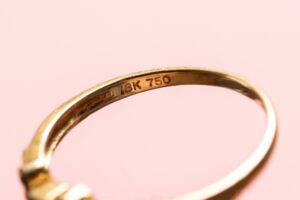Caring for your Jewellery while abroad
Heading to the Mediterranean this season? While you soak up the sun, make sure your diamonds are just as radiant when...
Have you ever looked on the inside of a ring and seen numbers or markings? Perhaps it isn’t located inside of a ring, but in another inconspicuous place, such as the clasp of a necklace. These are jewellery stamps and they can have various meanings.
These stamps are meant to convey several things, and can be used to identify the metals used, the country of origin, and the maker of the piece. It’s important to note that not all jewellery will contain a stamp or mark, and, just because it has no mark does not mean that it isn’t genuine.
While this information is interesting, when shopping for new pieces, it’s more important which jewellery colour suits you. Regardless of the marks, it’s important to have your jewellery examined by a professional to verify any claims made by the stamps on your jewellery.
This is by far the most common type of mark found on custom-made gold jewellery in Melbourne and all over the world. For gold, you’ll typically see a mark that denotes the karats of gold: 14k, 18k, and 24k. 24k is the highest and denotes 100% pure gold. Karats may seem complicated but the measurement is actually quite simple:
Twenty-four is the total number of parts that make up the gold’s content. So, 14k gold means fourteen parts of the gold are actual gold, while the other ten parts are an alloy metal combined to give the gold strength. Gold purity may also be expressed as a three-digit number that matches the percentage of gold:

Silver, likewise, has purity marks that express the purity of the metal. They are typically numbered as follows:
Platinum and palladium have numbering systems similar to silver. Other metals used in jewellery, such as steel and other alloys, may also be marked with lettering or numbering, though this is rare.
We now know what those numbers mean, but why is there a lion stamped on the inside of my ring, and what are those strange letters? What you’re typically looking at are what is known as assay marks. These marks, given by government offices, certify the purity of jewellery to protect consumers from fraud.
Assay marks have been around for a very long time. The only issue with assay marks is that every country has its own assay marks, and regional offices of that country may have their own distinct assay mark–this can make assay mark identification difficult for an uninformed consumer.
To further complicate the issue, assay marks change over time. Because of this, it’s important to have your assay marks evaluated by professionals. Without their insight, it could be difficult to tell if you’re holding a ring that was made last week or a 14th-century relic.
Finally, we get to the maker’s marks. These markings can quite literally look like anything: lettering, a coat of arms, an animal, or geometric shapes. Maker’s marks are the oldest type of markings found on jewellery, dating back to before written records. A skilled artisan was proud of his work and wanted those who saw it to know its origins, and maker’s marks are still used today by fine jewellers throughout the world.
Jewellery is a rare craft in that it sometimes helps its owner understand its history. With a little knowledge, and possibly the help of a professional from Holloway Diamonds, you can learn everything there is to know about your latest acquisition.
Heading to the Mediterranean this season? While you soak up the sun, make sure your diamonds are just as radiant when...
When it comes to purchasing an engagement ring, the diamond isn’t the only star of the show. The setting style can...
Investing in gold jewellery is a time-honoured tradition that continues to shine in 2025. Gold has been a reliable...